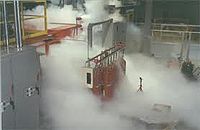Fire Suppression Systems
Fire Suppression Systems are commonly used on heavy power equipment. Suppression systems use a combination of dry chemicals and/or wet agents to suppress equipment fires. Suppression systems have become a necessity to several industries as they help control damage and loss to equipment. Common means of detection are through heat sensors, wiring, or manual detection. In the USA Fire Suppression systems are governed by the codes under the NFPA.
Common Functions
Vital to the functioning of the system is the fire detection and control network. Typically detectors sense the presence of smoke in the protected facility. The detection and control panel then sounds an alarm, performs pre-determined auxiliary functions and releases agent into the protected area.
Common Types
Heptafluoropropane Fire Suppression Systems
Heptafluoropropane is a fire suppression agent manufactured and is a replacement agent for the ozone depleting Halon 1301 used extensively before 1994. Just as with Halon 1301, people can be exposed to normal extinguishing concentrations of Heptafluoropropane without any fear of health problems. Heptafluoropropane is a safe, no-residue protection for Class A, B and C type fires and has zero ozone depletion potential.
Inergen Fire Suppression Systems
Inergen is an environmentally friendly three dimensional fire suppression agent replacing Halon 1301. Critical facilities such as data processing rooms, telecommunications switching facilities, process control rooms, and others require a non-water based extinguishing agent that: Is electrically nonconductive, Is safe for use in human occupied facilities, Will not damage sensitive electronic equipment, Has zero ozone depletion, zero global warming, and zero atmospheric lifetime.
Carbon Dioxide Fire Suppression Systems
Carbon dioxide is recommended for the protection of unoccupied facilities. CO2 is economical and can be selected as a local application or total flooding system.
Video
